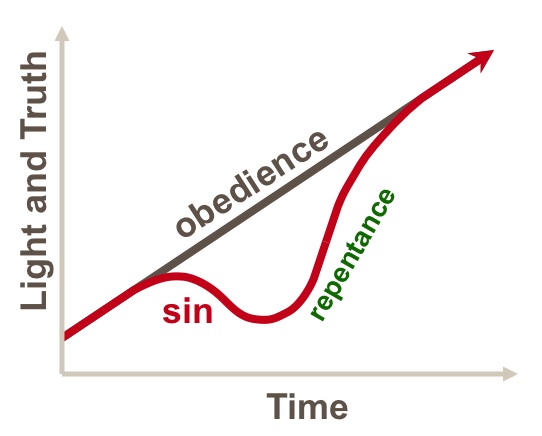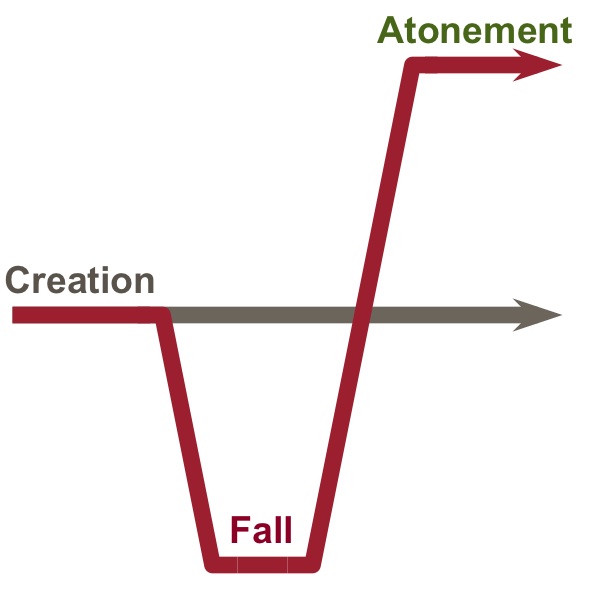| Recap: There are two types of spiritual death. Temporal separation is caused by the Fall of Adam and Eve, and it is overcome unconditionally for everyone at the Judgment. Spiritual separation is caused by individuals’ sins, and it is overcome only for the repentant through the baptismal covenant. |
I ended my last post by talking about two complementary errors: believing that sin is necessary, and believing that sorrow and suffering are not. In this post, I want to tie together several threads of thought which I have been developing over the course of two years and sixteen articles. I hope I’m not beating a dead horse; my purpose in adding another post to this topic is to explore the question of why so many people fall into these two errors.
I’m mentally wringing my hands, though, because the two true doctrines I discuss here can both involve tender feelings. The problem of pain and the doctrine of repentance both involve our most sensitive experiences. I really worry that, in my effort to be as concise as possible (to make this readable rather than boring), I’ll inadvertently end up mowing over someone’s feelings. Please give me the benefit of the doubt. If I don’t explain the doctrine well, please believe that I tried. If you don’t believe the doctrines as I’ve presented them, please at least assume I have good intentions, and don’t think that I’m an insensitive cretin who’s never experienced real pain in my life. (I am a cretin, and I’m often insensitive, but my point is that I’m desperately trying not to be.)
For the rest of this post (and pretty much throughout all of my writings), I will use sorrow to refer to the suffering, affliction, and pain that result from those unpleasant but necessary elements of this mortal, fallen world—death, disease, accidents, and so on. I will use misery to refer to the spiritual darkness, guilt, and anguish that result from those unpleasant and unnecessary personal sins we all commit—immorality, pride, anger, deceit, malice, disobedience and distrust toward God, and so on.1 We may sometimes use fuzzy language and call both types of experience the same word, like “pain” or “evil,” but they are qualitatively different.
Unnecessary Pain
In the series The Path of Sin, I illustrated two possible paths our lives could take with respect to misery. Perfect obedience would prevent us from ever experiencing the misery of sin, which would be no loss to our personal growth. Sin leads us on a needless detour from which we are mercifully rescued by the Atonement. Granted, the Savior’s sacrifice and love can transform those miserable experiences into lessons that we learn from, but our sins were not the only way to learn those lessons. I summarized that idea in the form of a chart.
Another way of summarizing this is by saying, “Pain, suffering, anguish, and affliction could and should be avoided” … if we are using those terms to mean the misery of sin. However, traditional Christianity has misinterpreted the doctrines of the Fall such that many believe that the sorrows of mortality could and should have been avoided, if only Adam and Eve had not been so foolish. Notice that their incorrect diagram of the Fall of Adam looks awfully similar to the correct diagram of sin:
| Correct View of Sin | Wrong View of Adam’s Fall |
|---|---|
 |
 |
Who makes this mistake: Traditional Christianity The cost: Not fully understanding of the purpose of pain and trials (i.e., they’re not just to reverse the effects of or punish us for sin) |
|
I have tried to color code the charts to show the parallels. In both cases, the original, grey path continues in a straight line, undeviating from its initial course. The divergent, red path turns downward but then rises to meet exactly equal with the original, grey path. In both cases, the graph represents someone who deviated from the condition they started in (the blue text) and is brought back up through a process made possible by the Savior (the green text), restoring the person to the course they should have been taking all along—without any ultimate loss, but neither with any gain.
Perhaps this similarity between the two concepts is partially to blame for the mistake that creedal Christianity has made with respect to the Fall of Adam. Their urgent and correct conviction that sin is a needless waste of time has facilitated the mistaken idea that pains and trials are likewise needless, or at least, would have been needless if we’d never sinned.
For example, ___ find a quote
Dana’s dating philosophy
The irony of Buddhism is that they do understand that joy is only possible with the concomitant possibility of sorrow. However, the Buddha’s solution is to avoid both. I’m no religious expert, but in my limited experience, what they call peace is also called emptiness, and seems to me to be very like the idea of “all things compound in one” that Lehi says would be the unfortunate result of no opposition, of staying in the garden (2 Ne. 2:11). Thus, the Buddhist attitude toward suffering, in a way, oddly mirrors the traditional Christian attitude: if it were possible, we’d like to completely avoid it.
Necessary Pain
In the series The Path of Adam’s Fall, I illustrated two possible paths mankind could take with respect to sorrow. Staying in Eden would prevent us from ever experiencing the sorrow of mortality, but that would retard our personal growth. Eating the fruit and leaving the painless (and joyless) garden leads us on a necessary journey through death and sorrow from which we are mercifully rescued by the Atonement. That fallen state is the only way to learn those lessons. I summarized that idea in a different chart.
Another way of summarizing this is by saying, “Pain, suffering, anguish, and affliction should not be avoided” … if we are using those terms to mean the sorrow of mortality. However, many individuals misinterpret the lessons gained from mistakes such that they believe that the misery of sin should not be avoided either. Notice that their incorrect diagram of sin looks very similar to the correct diagram of the Fall of Adam:
| Correct View of Adam’s Fall | Wrong View of Sin |
|---|---|
 |
 |
Who makes this mistake: New Age, Post-modern relativism The cost: Not understanding the importance of righteousness (i.e., the commandments are designed to protect us and make us happy) |
|
In both cases, the original, grey path continues in a straight line, undeviating from its initial course. The divergent, red path turns downward but then rises to a higher level than the original, grey path. In both cases, the graph represents someone who deviated from the condition they started in (the blue text) and is brought up to a better state through a process made possible by the Savior (the green text), exalting the the person to a greater degree of wisdom, insight, and love than was possible without the deviation.
Perhaps this similarity between the two concepts is partially to blame for the mistake that New Age-inspired ideas have made with respect to the effects of sin. Their correct realization that some mistakes are unavoidable, and that sorrow is the only way to learn some things, has facilitated the mistaken idea that actions that have traditionally been called sins are not only harmless, but even necessary if we are to learn.
For example, a friend of mine has been trying to overcome a pornography addiction. That recovery has been greatly aided by an LDS Twelve-Step program (similar to Alcoholics Anonymous). He has learned powerful truths, such as the idea that you cannot overcome problems like this on your own, but rather must rely on a higher power to effect a change in you. He has learned that pornography is a counterfeit for real human intimacy and connection, and he has learned that only by letting yourself be vulnerable can you really get close to someone.
However, sometimes this idea has been taken too far. This friend told me that sometimes in their group discussions, he will talk regretfully about the pain he caused his wife, and how it led to his recent divorce, which is taking its toll on their kids. In such moments, sometimes fellow group members will tell him not to feel too bad about it, because it was meant to be. After all, how else could he have learned such powerful lessons unless he had been driven to them by such desperate circumstances? My friend told me that he had embraced so many powerful truths in the course of his therapy, but that he had really wrestled with that idea. (That idea was expressed by one commenter on an LDS blog post by quoting John Lennon: “There’s ‘There’s ‘nowhere you can be that isn’t where you’re meant to be.'”)
We discussed the true doctrines about the path of sin, and he was intensely relieved by the idea that it did not have to be this way. “I did not have to learn these lessons by engaging in pornography and destroying my marriage. True, the Lord has redeemed those experiences and made them the vehicle of coming to know Him better. But sin was not the only way I could have learned them.” It was intriguing and gratifying to see him surrender the idea that his sins were necessary for him to draw closer to God, and to see the peace of mind that came because of it.
Avoiding the Errors in the Future
I believe this distinction is crucial to answer the problem of evil. In essence, what we call “evil”—any kind of unpleasant, inconvenient, or painful experience—can actually be divided into two qualitatively different kinds of pain. While they often seem very similar and virtually indistinguishable at times, when we have an eternal perspective, we see the difference very clearly. While we ma
Ben Spackman, Ra’ah Amos 3
http://www.mormonmonastery.org/does-god-commit-evil-some-quick-notes-on-amos-3/
Accusations from non-LDS Christians (Chris Welborn quote)
Accusations from New Age (find a quote ___ You’re hyper perfectionist; you set unrealistic expectations and don’t understand the importance of making mistakes. You deprive yourselves of valuable experience)
DHOaks, Sin v. Mistake: http://speeches.byu.edu/reader/reader.php?id=7718
How to avoid the errors: define our terms: mistake, pain, affliction, suffering
Both ideas meet resistance by some individuals.
How can you say that I wasn’t supposed to leave my wife? I’m now happily married to the woman I ran off with.
How can you say my loved one was supposed to have that disease?
Notes
1. My choice of the term misery comes mainly from Lehi’s sermon to Jacob (2 Ne. 2:11, 13, 18, 23). It is also for that reason that I suggested to Jeff that he use the title “Sorrow versus Misery” in his discussion of the problem of evil three years ago.